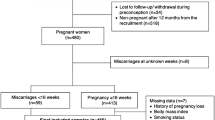Abstract
First trimester miscarriage is common, occurring in approximately 6.4-12.0% of pregnancies. Women who experience first trimester miscarriage will often have no other significant health conditions and the healthcare professional they most frequently visit could be their dentist or dental care professional. For this reason, it is important that the dental team is aware of the management of first trimester miscarriage in order to allow for a better understanding of the patient's experience and situation. The choice of language used by healthcare professionals with patients who are grieving is also important to ensure effective and open communication.
This article aims to provide the dental team with knowledge of first trimester miscarriage, how the effects of this can be relevant within the dental setting, and how to communicate effectively and appropriately with patients who have experienced this traumatic event.
Key points
-
First trimester miscarriage is common, occurring in approximately 6.4-12% of all pregnancies.
-
First trimester miscarriage can have significant physical and psychological effects on patients, the implications of which should be recognised from a dental perspective.
-
When communicating with patients who have recently miscarried, the dental team has a role to play in ensuring that language is supportive and appropriate for the individual patient's needs.
Similar content being viewed by others
Log in or create a free account to read this content
Gain free access to this article, as well as selected content from this journal and more on nature.com
or
References
Jurkovic D, Overton C, Bender-Atik R. Diagnosis and management of first trimester miscarriage. BMJ 2013; DOI: 10.1136/bmj.f3676.
Linnakaari R, Helle N, Mentula M et al. Trends in the incidence, rate and treatment of miscarriage - nationwide register-study in Finland, 1998-2016. Hum Reprod 2019; 34: 2120-2128.
Bardos J, Hercz D, Friedenthal J, Missmer S, Williams Z. A National Survey on Public Perceptions of Miscarriage. Obstet Gynecol 2015; 125: 1313-1320.
Royal College of Obstetricians & Gynaecologists. The Investigation and Treatment of Couples with Recurrent Firsttrimester and Second-trimester Miscarriage. 2011. Available at https://www.rcog.org.uk/globalassets/documents/guidelines/gtg_17.pdf (accessed April 2020).
Royal College of Obstetricians & Gynaecologists. Late Intrauterine Fetal Death and Stillbirth. 2010. Available at https://www.rcog.org.uk/globalassets/documents/guidelines/gtg_55.pdf (accessed April 2020).
Office for National Statistics. Child and infant mortality in England and Wales: 2018. 2020. Available at https://www.ons.gov.uk/peoplepopulationandcommunity/birthsdeathsandmarriages/deaths/bulletins/childhoodinfantandperinatalmortalityinenglandandwales/2018 (accessed April 2020).
National Childbirth Trust. Miscarriage: your questions answered. 2020. Available at https://www.nct.org.uk/pregnancy/miscarriage/miscarriage-your-questions-answered (accessed April 2020).
Knez J, Day A, Jurkovic D. Ultrasound imaging in the management of bleeding and pain in early pregnancy. Best Pract Res Clin Obstet Gynaecol 2014; 28: 621-636.
Ford H, Schust D. Recurrent Pregnancy Loss: Etiology, Diagnosis and Therapy. Rev Obstet Gynecol 2009; 2: 76-83.
Hutchon D J. Understanding Miscarriage or Insensitive Abortion: Time for More Defined Terminology? Am J Obstet Gynecol 1998; 179: 397-398.
Farquharson R, Jauniaux E, Exalto N. Updated and revised nomenclature for description of early pregnancy events. Hum Reprod 2005; 20: 3008-3011.
Norton W, Furber L. An exploration of how women in the UK perceive the provision of care received in an early pregnancy assessment unit: an interpretive phenomenological analysis. BMJ Open 2018; DOI: 10.1136/bmjopen-2018-023579.
NHS Business Services Authority. Can I still claim free NHS dental treatment if I've had a miscarriage/stillborn birth? 2020. Available online at https://nhsbsa-live.powerappsportals.com/knowledgebase/article/KA-02142/en-us (accessed September 2020).
Sapra K, Joseph K, Galea S et al. Signs and Symptoms of Early Pregnancy Loss. Reprod Sci 2016; 24: 502-513.
Snell B J. Assessment and Management of Bleeding in the First Trimester of Pregnancy. J Midwifery Womens Health 2009; 54: 483-491.
Matthews M. Evaluation and Management of First-Trimester Bleeding. Postgrad Obstet Gynecol 2012; 32: 1-7.
Moore J. Early pregnancy units and problems in early pregnancy. Curr Obstet Gynecol 2006; 16: 327-332.
Ankum, Willem M. Medical Management of First Trimester Miscarriage Did Not Improve Outcome, Compared to Expectant Management. Evid Based Obstet Gynecol 2000; 2: 44.
NICE. Ectopic Pregnancy and Miscarriage: Diagnosis and Initial Management. 2019. Available at https://www.nice.org.uk/guidance/ng126/resources/ectopic-pregnancy-and-miscarriage-diagnosis-and-initial-management-pdf-66141662244037 (accessed April 2020).
Webster, Katie et al. Ectopic Pregnancy and Miscarriage: Diagnosis and Initial Management: Summary of Updated NICE Guidance. BMJ 2019; DOI: 10.1136/bmj.l6283.
Ballagh S A, Harris H A, Damasio K. Is curettage needed for an uncomplicated incomplete abortion? Am J Obstet Gynecol 1998; 179: 1279-1282.
Sotiriadis A, Makrydimas G, Papatheodorou S, Ioannidis J P. Expectant, Medical, or Surgical Management of First-Trimester Miscarriage: A Meta-Analysis. Obstet Gynecol 2005; 105(5 Pt 1): 1104-1113.
Shelley J, Healey D, Grover S. A randomised trial of surgical, medical and expectant management of first trimester spontaneous miscarriage. Aust N Z J Obstet Gynaecol 2005; 45: 122-127.
Cubo A M, Soto Z M, Haro-Pérez A, Hernández M E H, Doyague M J, Sayagués J M. Medical versus surgical treatment of first trimester spontaneous abortion: A cost-minimization analysis. PLoS One 2019; DOI: 10.1371/journal.pone.0210449.
Hogge W A, Byrnes A L, Lanasa M C, Surti U. The clinical use of karyotyping spontaneous abortions. Am J Obstet Gynecol 2003; 189: 397-400.
Bicking Kinsey C, Baptiste-Roberts K, Zhu J, Kjerulff K H. Effect of multiple previous miscarriages on health behaviours and health care utilization during subsequent pregnancy. Womens Health Issues 2015; 25: 1550-1561.
Kamalanathan S, Sahoo J P, Sathyapalan T. Pregnancy in polycystic ovary syndrome. Indian J Endocrinol Metab 2013; 17: 37-43.
Di Prima F A F, Valenti O, Hyseni E et al. Antiphospholipid Syndrome during pregnancy: the state of the art. J Prenat Med 2011; 5: 41-53.
Cowchock S. Treatment of antiphospholipid syndrome in pregnancy. Lupus 1998; 7(2-suppl): 95-97.
The Miscarriage Association. Why me? 2015. Available at http://www.miscarriageassociation.org.uk/wp-content/uploads/2016/10/Why-Me.pdf (accessed April 2020).
Nynas J, Narang P, Kolikonda M K, Lippmann S. Depression and Anxiety Following Early Pregnancy Loss: Recommendations for Primary Care Providers. Prim Care Companion CNS Disord 2015; DOI: 10.4088/PCC.14r01721.
Beutel M, Deckardt R, von Rad M, Weiner H. Grief and depression after miscarriage: their separation, antecedents, and course. Psychosom Med 1995; 57: 517-526.
Due C, Chiarolli S, Riggs D W. The impact of pregnancy loss on men's health and wellbeing: a systematic review. BMC Pregnancy Childbirth 2017; 17: 380.
Darwin Z, Greenfield M. Mothers and others: The invisibility of LGBTQ people in reproductive and infant psychology. J Reprod Infant Psychol 2019; 37: 341-343.
Human Fertilisation & Embryology Authority. Fertility treatment 2017: Trends and figures.2019. Available at https://www.hfea.gov.uk/media/2894/fertility-treatment-2017-trends-and-figures-may-2019.pdf (accessed April 2020).
Peppers L, Knapp R. Maternal reactions to involuntary fetal/infant death. Psychiatry 1980; 43: 155-159.
The Miscarriage Association. The Miscarriage Association Forum. Available online at https://www.miscarriageassociation.org.uk/myBB/member.php (accessed April 2020).
Bellhouse C, Temple-Smith M J, Bilardi J E. "It's just one of those things people don't seem to talk about..." women's experiences of social support following miscarriage: a qualitative study. BMC Womens Health 2018; 18: 176.
The Miscarriage Association. Caring for women experiencing pregnancy loss: a new elearning resource. 2020. Available online at https://www.miscarriageassociation.org.uk/information/for-health-professionals/e-learning/ (accessed April 2020).
Findlay J, Gear M, Illingworth P et al. Human embryo: a biological definition. Hum Reprod 2006; 22: 905-911.
Medline Plus. Merriam-Webster Medical Dictionary. Springfield, MA: Merriam-Webster Incorporated, 2005.
Cahill D J. Managing Spontaneous First Trimester Miscarriage. BMJ 2001;DOI: 10.1136/bmj.322.7298.1315.
Allison J L, Sherwood R S, Schust D J. Management of first trimester pregnancy loss can be safely moved into the office. Rev Obstet Gynecol 2011; 4: 5-14.
Sappenfield E, Jamieson D, Kourtis A. Pregnancy and Susceptibility to Infectious Diseases. Infect Dis Obstet Gynecol 2013; DOI: 10.1155/2013/752852.
Feodour Nilsson S, Andersen P K, Strandberg-Larsen K, Nybo Andersen A M. Risk factors for miscarriage from a prevention perspective: a nationwide follow-up study. BJOG 2014; 121: 1375-1384.
Bhattacharya S. Modifiable risk factors for miscarriage identified. Evid Based Nurs 2015; 18: 72.
Maconochie N, Doyle P, Prior S, Simmons R. Risk Factors for first trimester miscarriage - results from a UKpopulationbasedcasecontrol study. BJOG 2007; 114: 170-186.
Gracia C R, Sammel M D, Chittams J et al. Risk Factors for spontaneous abortion in early symptomatic first-trimester pregnancies. Obstet Gynecol 2005; 106(5 Pt 1): 993-999.
Author information
Authors and Affiliations
Corresponding author
Ethics declarations
The authors have no conflicts of interest to declare for this article.
Rights and permissions
About this article
Cite this article
Barratt, O., Lee, R. & Curtin, C. First trimester miscarriage: patient care considerations for the dental team. Br Dent J 229, 527–531 (2020). https://doi.org/10.1038/s41415-020-2224-0
Received:
Accepted:
Published:
Issue date:
DOI: https://doi.org/10.1038/s41415-020-2224-0



